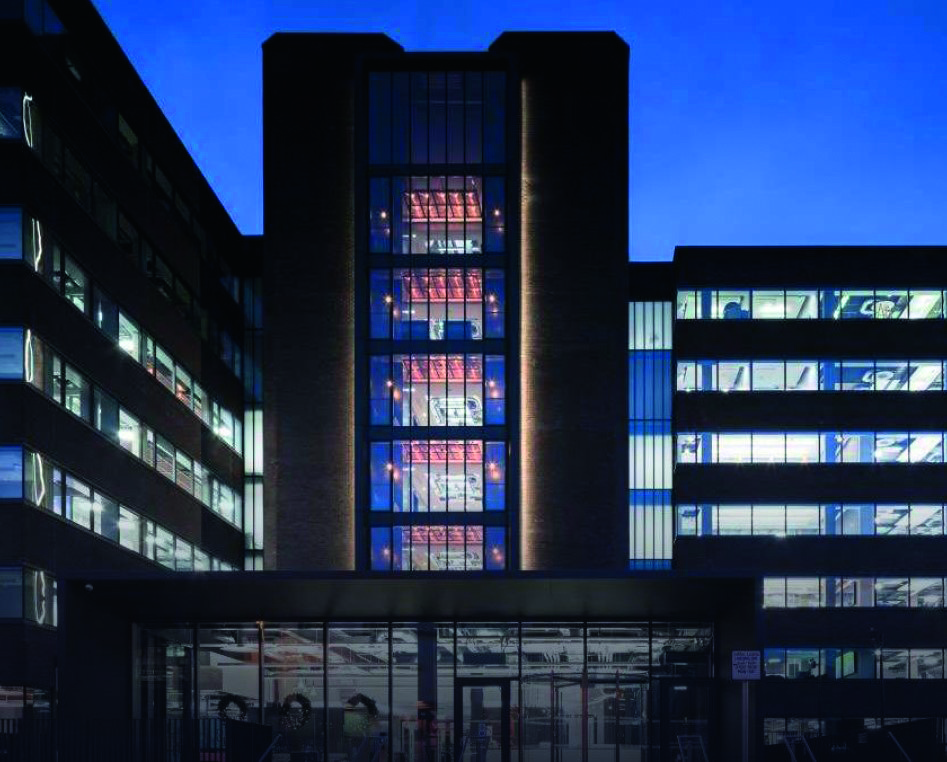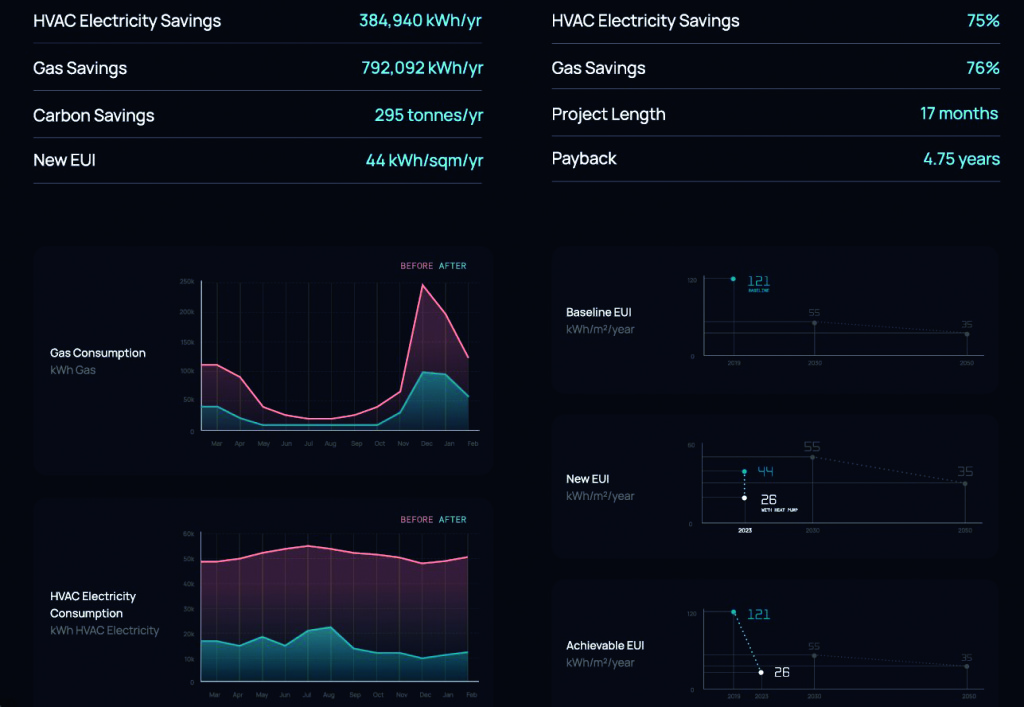Case Study: Government recognition for Smart Optimisation project

A high-tech energy-saving project at a prominent Dublin office building has helped bring about a 76% reduction in energy demand and been officially recognised by the Irish Government.
The project, which was carried out by Symphony Energy on behalf of Hibernia REG has earned a commendation from the Irish government and involved a digital retrofit to further reduce energy waste in what was already considered a highly-efficient building (LEED Platinum rated).
The building, 1 Cumberland Place, serves as the European HQ for social media giant X (formerly Twitter). It achieved LEED Platinum status in 2018 when the building underwent total refurbishment and the latest challenge was to deliver radical reductions in both gas and HVAC electricity demand without compromising on comfort levels.
Recently acquired by Brookfield Asset Management, Hibernia REG is a major Irish property group with a €1.5 billion portfolio primarily comprising high-quality offices in central Dublin.
It entered a five-month engagement initially with Symphony’s Smart Optimisation programme. This was followed by a 12-month Measurement and Verification (M&V) process. It resulted in HVAC electricity savings of 75%, gas savings of 76%, as
well as a significant drop in Base Building Energy Use Intensity (EUI) from 121 to 44.
Mapping and Learning
Hibernia REG partnered with Symphony Energy in 2022 to identify energy inefficiencies and create saving opportunities in the 11,984 sq.m office building.
Hibernia REG’s Director of Sustainability, Neil Menzies, said: “As an industry, we need to look beyond BERs and construction-only green building certifications to focus on in-use building performance.
"Having achieved LEED Platinum at 1CP in 2018, one of the first to be certified in Ireland, our recent partnership with Symphony has since helped us achieve incredible levels of energy efficiency.”
The project began with an extensive review of the building physics, HVAC design and installation, along with monitoring various BMS (Building Management System), weather forecasting and IoT data points via a Loytec LINX automation server. In order to add even more data to the picture, 119 Welltech smart sensor controllers were introduced to monitor the IEQ (Indoor Environmental Quality) of individual spaces throughout the building.
These were newly designed by Sympony’s in-house team and it was the first time they’d been used as part of a project toolkit. They allow monitoring of up to 10 key metrics including CO2, occupancy and temperature. In addition to providing real- time insights into ventilation requirements, the technology can control the local plant tasked to deliver the specified air quality while exchanging key data with the building management system (BMS).
The mapping and learning exercise revealed the environmental signature of the building from which a virtual model could be created in a building energy management platform, capturing key aspects of its energy dynamics and performance.
Custom performance algorithms were used within a controlled sandbox environment to conduct simulations, evaluating the response of the building’s energy systems under various demands and conditions.
This process allowed different strategies, configurations and scenarios to be tested, providing valuable insights into the performance of the building. Targeted opportunities for optimisation that would enhance the building’s energy performance were identified.
Optimisation
The next step was to align the virtual model of 1 Cumberland Place with the real building so that the optimised operational settings could be introduced.
With the Loytec LINX automation server acting as an additional brain for the BMS, the new settings were deployed from Symphony Cloud and began to run in place of the prior function of the BMS. The alignment process allowed seamless transformation of the HVAC energy performance of the building and immediately reduced its energy usage. Custom algorithms now continuously predict, monitor, and respond to real-time fluctuations in energy demand while delivering newly- optimised HVAC performance.

The sensor-controller is now focusing ventilation control by operating at a highly-localised level, effectively managing the airflow within the building as a collection of micro-environments. Fresh air supply precisely follows the demand as occupants transition from one area to another. As a result, the AHU (Air Handling Unit) plant can reduce its output, optimising energy consumption.
Even with reduced airflow in some areas, the sensor control is delivering more than the originally-designed quantity of air to spaces that require it so each individual area of 1 Cumberland Place receives superior Indoor Environmental Quality (IEQ) levels.
Waste heat is being recycled into usable heat while generating free cooling for the building. This process transfers the heated chilled water returning from the fan coil units, into the AHU cooling coils. These coils use the cool outside air to remove heat from the warmed chilled water so this water can return to the fan coils to collect more heat from rooms with surplus heat.
By cooling the chilled water in the AHU cooling coils, the incoming fresh air is heated. This in turn has the effect of mostly eliminating the need for any heating of the air by the heating system AHU heating coils.
Automation
All the relevant BMS data, new WellTech data and externally- sourced IoT data is merged onto Symphony’s cloud platform.
This provides key personnel with insights into the operation of the building and intervention tools for additional control.
Custom performance algorithms apply formulas across various fields and IoT data to form virtual data points that automatically optimise the control of the HVAC plant and provide unique insights into small but high impact operational nuances.
A spokesman for Symphony said: “Our algorithms are continuously learning and adapting to both seasonal forecast data and changing conditions within the building, allowing for automated, dynamic and responsive energy management at 1 Cumberland Place.”
The cloud platform can be merged with energy metering and other data sources. By hosting the BMS and associated virtual data, it can report key metrics to its own and other ESG reporting tools. Hibernia REG’s Head of Facilities Management, Brian Fitzpatrick, said the project had ‘revolutionised’ its facilities management. “We are delighted with the outcomes achieved at 1 Cumberland Place,” he said, adding: “The solutions have not only streamlined our operations but are playing a pivotal role in our sustainability journey.”
The results
The total building gas consumption was reduced by 69%. The HVAC portion was reduced to the order of 76% when the hot water services and cooking gas were factored out. The domestic hot water is generated by an independent system that was not part of the Symphony project.
The total landlord electricity consumption was reduced by 63%. The HVAC portion was reduced to the order of 75%. For 87% of the 2,946 cooling hours post implementation, Symphony Cycle supported the full cooling load of the building for free and the company estimates that this alone is responsible for 30% of the total energy savings.
The central HVAC energy intensity during the 12-month savings and verification was 44 kWh/sqm/yr. This represents an unprecedented energy performance for a gasheated, air-conditioned office building in Ireland.
The UKGBC Net Zero Carbon Buildings Framework sets out the Paris Proof EUI (Energy Use Intensity) targets for the Net Lettable Area (NLA) of commercial office spaces. With the successful completion of this project, 1 Cumberland Place has now exceeded its 2030 Paris Proof Interim EUI Target energy consumption of 55 kWh/sqm/yr.
By replacing the current boiler system with an energy-efficient heat pump, the building is set to achieve its 2050 Paris Proof EUI Target of 30 kWh/sqm/yr with an achievable EUI of 26 kWh/sqm/yr.







